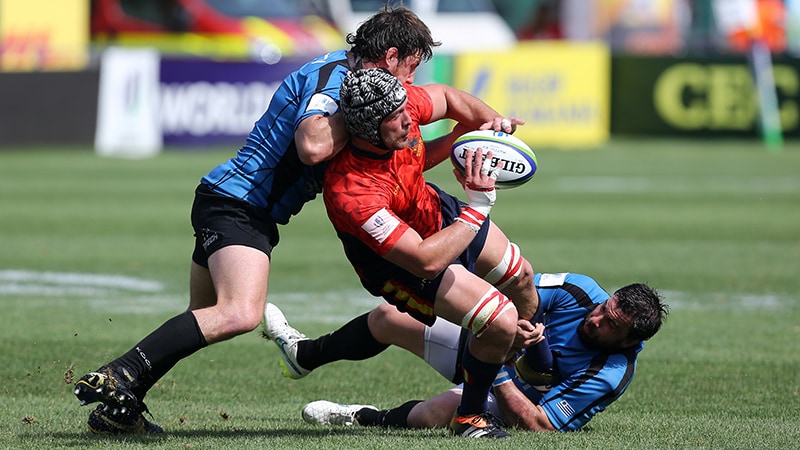Two studies led by researchers at Imperial College London (ICL) have identified structural brain changes and blood biomarkers linked to dementia in former professional rugby players.
The findings provide the first prospective evidence of physical brain and blood abnormalities in this group.
Previous research had already shown that elite rugby players face a higher risk of neurodegenerative diseases later in life. The studies examined links between repeated head impacts in rugby and conditions such as Alzheimer’s disease and chronic traumatic encephalopathy (CTE).
Post-mortem examinations of former players have shown neuropathologies consistent with repetitive brain trauma.
Traumatic brain injury, already a known risk factor for neurodegeneration, contributes to an estimated 3%-15% of dementia cases in the general population.
While recent advances in fluid and imaging biomarkers have transformed dementia diagnosis, these techniques have not been systematically applied to rugby players previously exposed to multiple head impacts.
Study Cohort and Methods
The research involved 200 ex-professional rugby players aged 30 to 61 (median age, 44), all of whom had self-referred with brain health concerns but had no dementia diagnosis at baseline. At least one previous concussion while playing was reported by 193 (96.5%) of the former players, with a median of seven concussions.
The rugby group was compared with 33 age- and sex-matched healthy controls with no evidence of previous head trauma or dementia onset.
Participants were 90% male. The median rugby career lasted 10.5 years, with 63% playing as forwards and 37% as backs.
Mental Health and Behavioural Symptoms
The former players scored higher on self-rated scales of depression, anxiety, and post-concussion symptoms than those in the control group, though not on sleep quality.
These symptoms, along with behaviour ratings of executive dysfunction and neuropsychiatric symptom severity, were more prevalent among individuals who had experienced a greater number of self-reported concussions. However, this was unrelated to the number of years played, or position of play.
Despite frequent subjective memory complaints, the performance of players in cognitive testing did not differ significantly from that of the control group. However, 24 former players, particularly those who had played as forwards and those who had reported more concussions, met the research criteria for CTE syndrome based on neurobehavioural disturbance. This was determined with low provisional levels of certainty: 21 were classed as ‘suggestive’, three as ‘possible’, and none as ‘probable/definite’. Seven of the 24 had cognitive impairment, 12 had neurobehavioral dysregulation, and five had both.
Imaging Findings
3T MRI imaging showed the presence of cavum septum pellucidum in 24% of players, compared with 12% of controls. This was more common in those who had experienced more concussions. They also showed reduced volumes in the frontal and cingulate cortices, with reduced white matter and lower hippocampal volume associated with longer career durations.
Only 4.6% showed trauma-associated white matter changes on diffusion tensor imaging.
Elevated Blood Biomarkers
Using ultrasensitive digital enzyme-linked immunosorbent assays, researchers analysed fluid biomarkers associated with neurodegeneration.
Key findings included:
- Phospho-tau217 levels were 17.6% higher in former players
- 23.1% had elevated phospho-tau217
- 9.0% had raised plasma neurofilament light
While levels were lower than in late-onset Alzheimer’s patients, players with elevated markers had more severe neuropsychiatric symptoms, including depression and anxiety.
Frontal brain volumes correlated negatively with neurofilament light, and hippocampal volumes correlated negatively with phospho-tau217.
The findings were published simultaneously in two papers in the journal Brain.
Professor David Sharp, director of the UK Dementia Research Institute Centre for Care Research & Technology at ICL, who co-led the work, said: “We didn’t see any cases of early dementia in this group of former players, which is reassuring. However, the changes in blood biomarkers and brain imaging abnormalities show some long-term effects of repeated head impacts on the brain.”
The studies are set to continue for a further 4 years.
Calls for Action on Player Safety
“Nearly half of dementia cases are linked to known health and lifestyle risk factors, including traumatic brain injury from contact sports like rugby,” said Dr Jacqui Hanley, head of research at Alzheimer’s Research UK. While not much is known about how such injuries cause changes to the brain, “deepening our understanding could ultimately help lower dementia risk for professional sportspeople”.
Hanley called for stronger efforts to reduce head injury in contact sports, stating: “Reducing traumatic brain injury in contact sports is critical to help prevent brain damage and minimise dementia risk for the players.”
The Alzheimer’s Society echoed the concern, noting that professional rugby players face approximately twice the risk of dementia. They called for accurate data on injury patterns and their long-term effects. However, they also stressed that physical activity remains one of the most effective ways to reduce dementia risk.
The Dementia Trust has warned that repeated tackles, scrums, and collisions can contribute to CTE among rugby players, and noted a rise in early-onset dementia among retired professional players.
In 2023, a group of 260 former professionals launched a lawsuit against World Rugby, the Welsh Rugby Union, and the Rugby Football Union. They alleged negligence in failing to protect players from the risk of neurodegenerative diseases.
Dr Sheena Meredith is an established medical writer, editor, and consultant in healthcare communications, with extensive experience writing for medical professionals and the general public. She is qualified in medicine and in law and medical ethics.
